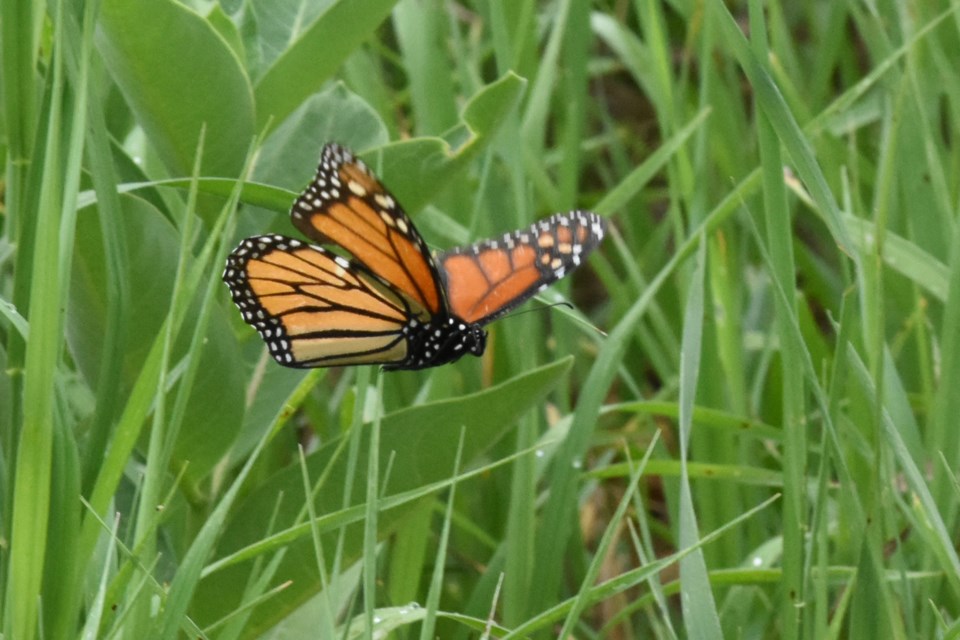This week’s column is going to get a few folks upset, yet perhaps will calm a few other folks down ... such is life these days.
Actually, this topic will take two columns to adequately cover all the nuances. The critter causing the ruckus is the monarch butterfly, that orange-and-black icon of summer fields and sunny days.
The problem is this: wild populations of monarch butterflies are dropping in number, drastically. This species is classified as endangered in Canada, while graded “only” as 'special concern' in Ontario. Being special concern it is not covered by the Endangered Species Act which protects the species and its habitat.
I heard a rumour that the province was considering moving the monarch to an endangered status, but that would mean coming up with a recovery plan within two years (which they have not done on other species over the past numerous years). Not holding out hope for that to happen.
Compounding the problem are people — people with emotion, empathy and a caring soul. As any wildlife manager will tell you, people with emotion are a hard lot to sway away from their chosen ‘holy grail’, in this case the rally cry being to “save the monarch butterfly.”
While emotion and compassion can motivate many to get the job done (which is usually a good thing), it can also get in the way of science. The monarch situation can also become a rich pool of financial gain for those who wish to make a dollar off your emotional state — science be damned.
Here’s the simple scenario: monarch butterfly caterpillars eat milkweeds, and monarch butterfly populations are crashing. A quick check of the landscape and it’s easy to observe that many fields that once grew milkweeds now sport houses, sterile lawns, and swimming pools.
So it is reasonable to think that planting more milkweeds will help the starving caterpillars, and by protecting them from predators will ensure more adults will emerge. Bingo, problem solved.
Not so fast. There are a number of other contributing factors to this tale of woe, including habitat loss, subspecies ranges and identification, and the spread of disease within a weakened and overstocked population.
And ... let’s take a look at the big picture. These butterflies do not spend all year with us, they cover a transcontinental migration route that includes four to five generations to complete the route. So whatever happens in Mexico and the U.S.A. also will have an effect on the monarch butterfly and its kin that are currently flitting across our local meadow.
Adding to the confusion is that some biologists feel there is a western and an eastern subspecies of monarch butterfly, with the western clan being reduced in population by 99 per cent, which means the survivors truly are endangered. However, other biologists believe the North American species of monarch is all one and the same, and while now in low numbers in the west it is holding on a bit better in the east.
Therein lies a layer of confusion, especially when info is gleaned from a quick Google search, as to what is really happening with these insects. Bottom line is that we know the overall population is on a downwards trend. How do we know that?
We know that because all the monarchs spend their winter in Mexico, huddled together in one forest stand. Researchers down there measure the area (acreage) covered by overwintering monarchs, and it is this data that confirms the area of coverage has dropped from 45 acres down to about five in the last few years.
So now we become inflamed with our emotions ... somebody has to do something! And suddenly there are initiatives to plant milkweeds, everywhere. And pollinator gardens, everywhere. But strangely, not that many more monarchs have been found, anywhere.
Part of that perplexing answer may lay with the fact that what was once a rolling farm field dotted with pink-flowered milkweeds is now a vast, sprawling, dense, hard surface, mass of humanity. With a one metre-by-one metre ‘milkweed garden’ being the only suitable habitat stuck somewhere in the middle.
Note: I’m not saying these urban gardens are bad or useless (indeed the wider serving pollinator gardens have huge benefits), just don’t expect to replicate a monarch utopia (despite having the streets names after the animals that were displaced (e.g. Monarch Drive, Mariposa Place, etc.).
The reality of providing habitat availability goes back to protecting what already exists from development. But it is a very hard argument to make in front of local council to save that 50 acres for butterflies, or develop it for untold millions of dollars of tax and permit revenue. Hard truth.
One of the other threats to monarchs surviving these days is the fanatical mowing of all things mowable in our public lands. I agree that long grasses provide suitable homes for ticks, and that’s the last thing anyone wants in their park, but again it’s a hard truth when it comes to balancing public health and safety with, you know, a butterfly.
So it is indeed an uphill battle to stop the downhill slide of this butterfly’s population. We all want to help, and many will admirably try anything to assist these beautiful creatures.
Which brings me to next week’s column: butterfly rearing and breeding and the potential environmental disasters that are hidden within that very controversial program. Until then, enjoy the summer weather (and keep your eyes open for any monarchs passing by).



